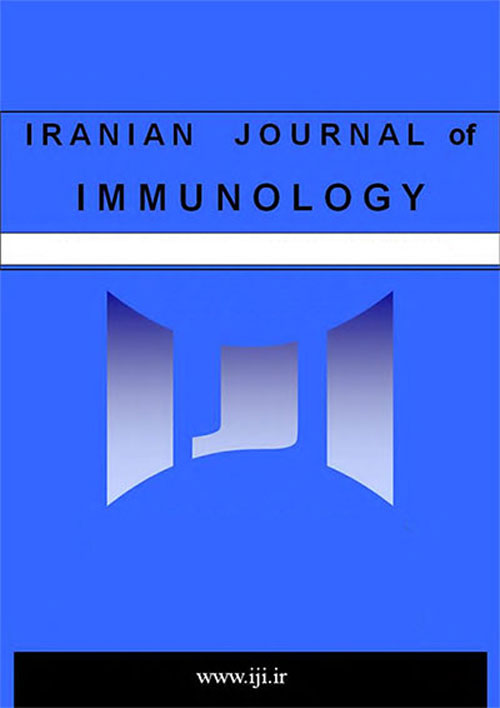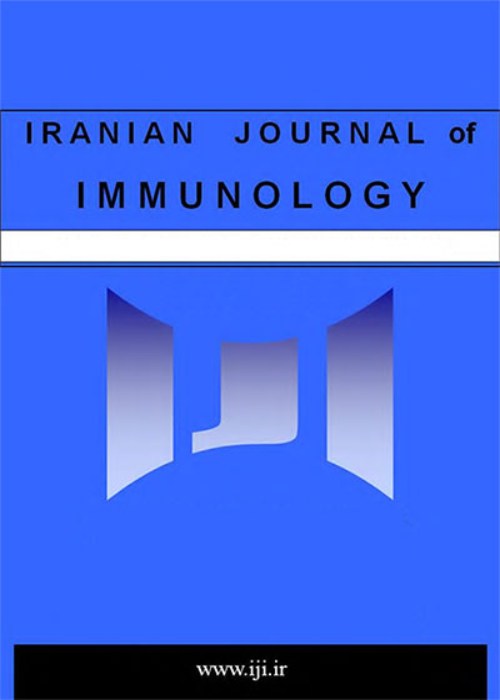فهرست مطالب

Iranian journal of immunology
Volume:15 Issue: 1, Winter 2018
- تاریخ انتشار: 1397/01/27
- تعداد عناوین: 7
-
-
Pages 1-13BackgroundPatients with unclassified hypogammaglobulinemia (UCH) constitute a diagnostic and therapeutic dilemma, because information concerning the clinical and immunological characteristics of these patients is insufficient.ObjectiveTo evaluate B-cell subsets in cases with UCH and common variable immunodeficiency (CVID) and their association with treatment requirement in UCH patients.MethodsThe study included 41 UCH, 25 CVID, and 36 healthy individuals between the ages of 4-18 years.ResultsThe absolute count of total memory and switched memory B-cells were lower in the CVID cases in comparison to the control group. Additionally, the absolute count of marginal zone-like B cells in the 4-10 year age group, and the absolute count of switched plasmablasts in the 10-18 year age group were lower in CVID cases when compared to both the control and UCH groups. The UCH group was categorized based on IVIG replacement therapy. Therefore, the percentage of switched memory B cells was significantly lower in the IVIG-receiving group (10.6% ± 3.10%) compared to the control group (14.0% ± 5.60%). However, there was no significant difference between the IVIG-receiving group and the CVID group. Regarding the comparison of the non-IVIG replacement group and the CVID group, the absolute count of total memory B cells, marginal zone-like B cells, and switched memory B cells were significantly higher in the UCH group.ConclusionB-lymphocyte subsets in UCH cases that did not require IVIG replacement were similar to the control group. On the other hand, the percentage of switched memory B-cells in the UCH cases that required IVIG replacement was not different from that of the CVID cases.Keywords: B Cell, Hypogammaglobulinemia, Immunodeficiency, Unclassified
-
Pages 14-27BackgroundIGF-1 and certain other cytokines have been shown to exert inflammatory/anti-inflammatory roles in chronic joint diseases.ObjectiveTo assess the effect of IGF-1, IL-27 and IL-35, their interaction and their receptor expression in a rheumatoid arthritis model.MethodsFreunds adjuvant-induced chronic joint inflammation was operated on 160 male rats. Animals were divided into histopathology and receptor expression groups, each composed of 10 subgroups including; control, vehicle, IGF-1, IL-27, IL-35, their antagonists, IGF-127 antagonist and IGF-135 antagonist. After two weeks, vehicle or agonist/antagonists were injected into the joint space every other day until day 28 where joint histopathology was performed. The expression of IGF-1, IL-27 and IL-35 receptors were assessed by western blot analysis.ResultsIGF-1 did not show pro- or anti- inflammatory functions; endogenous IL-27 and IL-35, on the other hand, exerted inflammatory effects. IL-27 and IL-35 antagonists exerted the highest anti-inflammatory effects. The total inflammation scores were 0.55 ± 0.06, 4.63 ± 0.40, 3.63 ± 0.60, 2.50 ± 0.38 and 1.63 ± 0.40 regarding control, vehicle, IGF-1 Ant., IL-27 Ant. and IL-35Ant., respectively. IGF-1 receptor expression was reduced in chronic joint inflammation and all three antagonists augmented the IGF-1 receptor expression. IL-27 and IL-35 receptors were up-regulated by chronic joint inflammation.ConclusionOverall, the results demonstrated the pro-inflammatory role of endogenous IL-27 and IL-35 along with the over expression of their receptors in chronic joint inflammation. IL-27 and IL-35 antagonists exerted the most anti-inflammatory effects and increased IGF-1 receptor expression. These two antagonists may be potential agents for new treatment strategies in chronic joint inflammatory diseases.Keywords: Chronic Joint Inflammation, Histopathology, IGF, 1, IL, 27, IL, 35, Immunohistochemistry, Receptor Expression
-
Pages 28-37BackgroundHuman leukocyte antigen (HLA)-G is a nonclassical HLA class I molecule with modulatory effects on NK and T cells. Because HLA-G expression is frequently detected in different solid tumors, it may be involved in tumor immune evasion.ObjectiveThis study was designed to elucidate the prognostic value of HLA-G in hepatocellular carcinoma (HCC) and pancreatic adenocarcinoma (PADC). The influence of hepatitis B virus (HBV) infection on HLA-G expression was also evaluated in patients with HCC.MethodsHLA-G expression was investigated in tumor tissues from patients with HCC (n=74) or PADC (n=42) with immunohistochemical techniques. The presence of HBV genome was also examined in HCC tumor tissues by PCR.ResultsHLA-G expression was detected in 66% of PADC and in 31% of HCC samples. In contrast to HCC, HLA-G overexpression was associated with advanced stages and grades in PADC. HBV genome was detected in 31% of HCC samples but we found no correlation between HLA-G expression and the presence of HBV genome in these tumors.ConclusionOur findings showed that HLA-G overexpression in tumor tissue correlated with poor prognosis in PADC. HLA-G expression is apparently affected by the patients genetic background and other epigenetic factors rather than by HBV infection.Keywords: Human Leukocyte Antigen_G_Hepatocellular Carcinoma_Hepatitis B Virus_Pancreatic Adenocarcinoma
-
Pages 38-46BackgroundStudies have indicated that extraweight and obesity induce chronic inflammation, which can lead to other diseases such as cancers.ObjectiveTo evaluate the effects of two weight-lowering and anti-inflammatory agents including cinnamon, and turmeric, on serum levels of interleukin-17 (IL-17) as a pro-inflammatory cytokine.MethodsIn this study, 64 rats were designated in eight groups. The control group received normal diet. The other groups were fed with normal diet plus high cinnamon (3 mg/ml), high turmeric (3 mg/ml), high-fructose solution (30%), fructose solution with low (0.15 mg/ml) and high doses (3 mg/ml) of cinnamon and turmeric three times per week. The serum level of IL-17F was measured by enzyme-linked immunosorbent assay (ELISA).ResultsHigh fructose consumption led to an increase in the weight and serum level of IL-17. While, feeding with cinnamon and turmeric caused to decline weight but, surprisingly increased IL-17F levels.ConclusionAlthough, some studies have showed that cinnamon and turmeric supplementation decreased IL-17F under the standard diet, in the presence of high fructose diet and extraweight their effects were reversed and caused an increase in serum level of IL-17F.Keywords: Cinnamon, Fructose, Interleukin, 17, Inflammation, Overweight, Turmeric
-
Pages 47-58BackgroundCholera toxin (CT), responsible for the harmful effects of cholera infection, is made up of one A subunit (enzymatic), and five B subunits (cell binding). The release of cholera toxin is the main reason for the debilitating loss of intestinal fluid. Inhibition of the B subunit (CTB) may block CT activity.ObjectiveTo determine the effect of anti CTB-IgY against oral challenge with V. cholera in suckling infant mice.MethodsThe binding domain of cholera toxin was amplified and ligated into pET28a vector. The pET28a ()/ctb expression vector was confirmed by endonuclease digestion and sequence analysis. The expression of recombinant CTB in E. coli was performed by induction with IPTG. After immunizing the chickens with recombinant CTB, IgY was purified by water dilution method and NaCl precipitation and analyzed by SDS-PAGE. Moreover, the activity and specificity of the IgY antibody were assessed by ELISA.ResultsThe SDS-PAGE and western blot techniques showed that CTB protein was successfully expressed and specifically recognized by polyclonal antibodies against the cholera toxin. The oral administration of anti- (V. choleraर) in infant mice in challenge with active V. cholera bacterium demonstrated high rate of survival.ConclusionThe increase in the number of antibiotic resistant bacteria implies the necessity of finding novel antibiotics. Our results suggest the possibility of passive protection from purified IgY, hence implying that anti CTB-IgY may be useful in the treatment of cholera infections.Keywords: CTB, IgY Prophylaxis, Recombinant Protein, Vibrio cholerae
-
Pages 59-67BackgroundIncreased evidences have shown that unexplained recurrent spontaneous abortion (URSA) is associated with inflammatory responses and breakage of immunological autotolerance. Therefore, the balance between Th17 and Treg cells may elucidate the pathophysiology of URSA.ObjectiveTo investigate the serum concentration of regulatory and inflammatory cytokines associated with Treg and Th17 in both normal and URSA females.MethodsForty-six women with URSA and 28 non-pregnant control women with at least one successful pregnancy were included. Serum was obtained from both groups and stored at -70°C. The serum concentrations of IL-17, IL-21, IL-22, IL-10, and TGF-β were quantitatively determined by ELISA.ResultsThe levels of IL-17, IL-21, and IL-22 in sera were significantly higher (PConclusionOur results suggest that enhancement in Th17-associated cytokine levels and reduction in TGF-β may be one of the factors involved in URSA.Keywords: Cytokines, Th17, Treg, Unexplained Recurrent Spontaneous Abortion
-
Pages 68-73BackgroundProstate cancer is the third most common malignancy in men worldwide. Despite being a helpful biomarker in prostate cancer, prostate specific antigen (PSA) is affected by different factors including age, lifestyle, geographical region and ethnicity.ObjectiveTo determine the age specific serum PSA level among healthy Northern Iranian men and to compare the results of our study with the findings of other populations in the world.MethodsA total of 1271 men who were referred for routine check-up in a multispecialty hospital in the city of Rasht, in Northern Iran, were evaluated for their PSA levels by commercial ELISA method.ResultsThe normal age related prostate specific antigen range (0-95th percentile) in our study was 0.0-0.62 in men younger than 40 yrs; 0.0-0.75 ng/ml in 40-49 yrs; 0.0-0.91 ng/ml in 50-59 yrs; 0.0-1.33 ng/ml in 60-69 yrs; 0.0-1.45 ng/ml in 70-79 yrs group and 0.0-1.93 in subjects older than 80 yrs.ConclusionThe present study revealed the lowest upper limit of PSA level in all age groups in comparison to populations from different countries.Keywords: Age, Healthy Men, Prostate Specific Antigen, Reference Range


